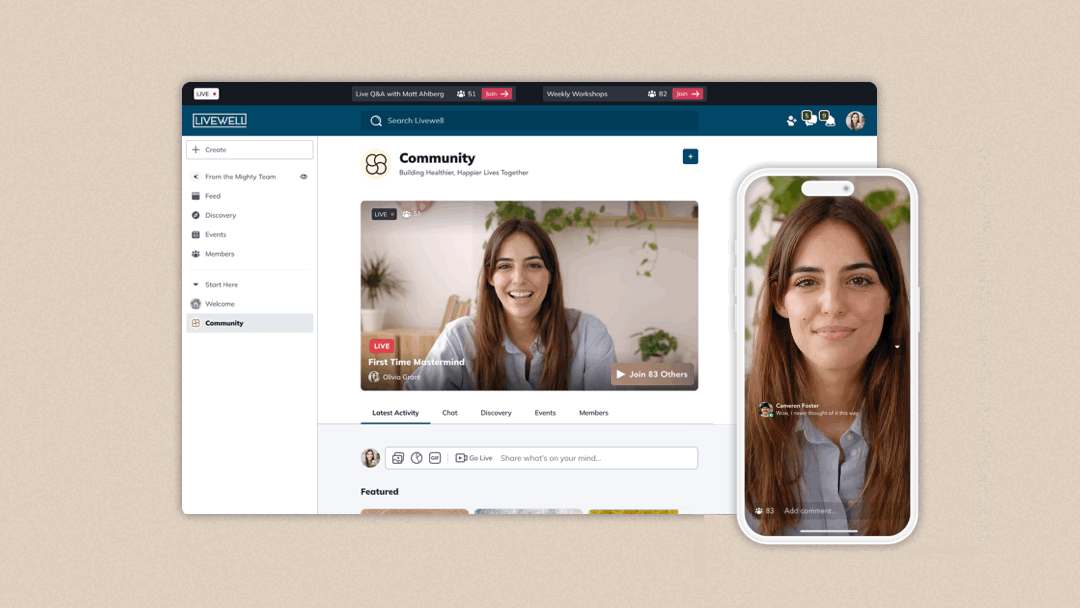Online Courses
The Best Teaching Styles for Delivering Course Material
Discover the pros and cons of different teaching styles to help you succeed in delivering course material.
Author
Mighty Team
Last Updated
February 6, 2025

Table of Contents
Intro
If you’re knowledgeable about a topic, have experience in a particular domain, or want to show others how you got to where you are today with practical tips and strategies, then you might have considered teaching. Teaching comes in many different formats, whether it’s through an online course (yes they’re still a thing — in fact, e-learning is expected to hit $1 Trillion by 2030), a virtual event (teaching students how to do tarot card readings), or even a mastermind group (like-minded individuals come together to learn from one another).

Whatever format you choose, you’ve probably also asked yourself, “What’s the best teaching style?” Because let’s face it, just as there’s not one way to learn, there’s not only one way to teach. Whether you’ve been teaching for years or an absolute newbie, learning the different teaching styles will not only help your students succeed, but it will also help you deliver the best content possible.
Here’s what we’ll cover in this article:
Why teaching styles are important.
The different types of teaching styles.
What the best teaching style is.
Why are teaching styles important?
There’s no one-size-fits-all when it comes to learning, and luckily, there are different teaching styles to match. Some people learn best visually (around 65% of the population learn best visually), others by listening, by reading and writing, or by doing (using all their senses).
And there are different teaching styles too. Teaching styles can shape the learning experiences of students and significantly impact their comprehension of the material.
Teaching styles are important because you can find your unique voice and approach as a teacher and because you can reach different kinds of learners.

What are the different teaching styles?
The different types of teaching styles vary on a spectrum, from a teacher-centered approach to a student-centered approach. With the former, the teacher is the authority figure — they deliver their content as planned, and the expectation is for students to simply listen and soak up the information.
On the other end of the spectrum, we have the student-centered approach. This approach is all about building connections with students, community-based learning, meeting students where they’re at, and tailoring the class to encompass their various needs.
While there are different ways to think about teaching style, the classic model is The Spectrum of Teaching Styles, introduced by Muska Mosston in 1966. But others have expanded on this work, and we commonly talk about five different teaching styles: lecturer, demonstrator, blended, facilitator, and delegator.
We’ll go through the teaching styles from more teacher-centered to more student-centered.

Lecturer
This type of teaching style is ideal for — you guessed it — lecturing a large group of students.
Lecturing involves the teacher taking a central role and is a one-way communication approach. It’s also structured and organized, and the content has been well planned out. Lecturing can be done synchronously (students are learning live as the teacher is presenting) or asynchronously (students learning at their own pace like with a pre-recorded course).
Since there’s so many people in attendance, there’s not enough time or space as the teacher is presenting for more individualized interactions with the students. That doesn’t mean students can’t ask questions at the end of the presentation or lecture.
This type of teaching style is best suited for large groups of students, whether it’s a virtual instructor-led training, a live webinar, or a pre-recorded course.

Pros of the lecturer teaching style
Efficiency: Teachers can efficiently cover a lot of material with a large number of students at once.
Scalability: The content delivered is the same every time, making it easy to prepare the material and consistently deliver it whether it’s to 100 or 1000 students.
Structure: This type of teaching typically follows a structured format, making it easier for students to follow along because they have an idea of what to expect.
Accessibility: Materials such as slides or notes can be made available to students for review afterwards.
Cons of the lecturer teaching style
Passive learning: This teaching style tends to promote passive learning, where students are receivers of information rather than active participants in the learning process.
Lack of engagement: Students may become disengaged or bored during long lectures and may not be able to retain all the information that was presented.
Not accommodating: There is limited opportunity for interaction and feedback between students and the teacher in this traditional format. This lecturer teaching style is also much more rigid and doesn’t address different types of learning styles.
Not focused enough on comprehension: Teachers may focus more on delivering the content rather than facilitating deeper understanding, critical thinking, and application of knowledge.

Demonstrator
A live event that shows students how to sketch is an example of the demonstrator teacher style. This teaching style encourages student involvement by brainstorming strategies, asking questions to prompt discussion amongst their peers, and practicing what they just learned. For example, ArtSnacks Mix offers curated art supply kits with live online classes to learn how to use them–a great demonstrator approach. This approach is mostly teacher-centered but does include student participation.
Demonstrator teacher style is less rigid than the lecturer style — going beyond the lesson to include exercises, group discussions, and other visuals (e.g., films).
This type of teaching style is best suited for showing, not just telling where students practice what they’re learning. Think workshops (e.g., cooking classes, crafting sessions, or learning how to do magic) and virtual events.

Pros of the demonstrator teaching style
Reinforce learning: Visual demonstrations encourage active participation making concepts more memorable.
More feedback: During demonstrations, teachers can provide immediate feedback to students, correcting any mistakes and reinforce the right technique or approach.
Increase interest: The demonstrator style can add variety to the learning environment, breaking up lectures or readings with hands-on activities and visual demonstrations, which helps keep things fresh by maintaining student interest.
Boost in confidence: By watching demonstrations and successfully completing tasks themselves, students build their confidence. This creates a domino effect by increasing students’ motivation to tackle more challenging material and tasks.
Cons of the demonstrator teaching style
Difficult for larger groups: Individualized feedback to students may be extremely challenging with a large group of students.
Resource intensive: This teaching style often requires access to specialized equipment, materials, and resources. Teachers with limited budgets may struggle to provide the necessary assets.
Time-consuming: This type of teaching style is not only time-consuming to prepare but takes time for the demonstration itself, which isn’t the best teaching style for covering a large amount of content.
Inflexibility: The demonstrator teaching style doesn’t accommodate for diverse learning styles and preferences. Some students may struggle to learn effectively through visual demonstrations alone and may require alternative teaching approaches to fully grasp the material.

Blended
As the name suggests, this type of teaching style offers a mix of teacher-centered and student-centered approaches. Some refer to this teaching style as hybrid, but there’s actually a difference. Blended teaching is when an instructor uses a variety of learning mediums to teach students (both in-person and online), for example, they may have a discussion board, or online project. In contrast, the term hybrid learning refers to both virtual and in-person students in a simultaneous learning experience.
With this type of teaching style, an online community is a great place where students share insights and ask questions. Teachers can increase engagement by spotlighting students (getting them to talk about their hopes, dreams, and goals, and ask the other students to welcome them), moderating the community so students feel safe to share without fear of being bullied or victimized, and diversifying content (e.g., full-length articles, polls, photos and videos).
Blended teaching offers the best of both worlds: students can learn at their own convenience yet still meet up with fellow students IRL.
This type of teaching style is best suited for teachers who want flexibility and want to engage their students in a variety of ways. Blended teaching isn’t just for academia; it’s also used in the corporate world. Just look at Walmart, which offers the One Global Walmart Academy, blending live and virtual learning opportunities for their 2.3 million employees.

Pros of the blended teaching style
Accommodates various students' needs: UNESCO reports lower education completion rates for learners with disabilities — higher dropouts, and lower overall literacy. Blended learning can be a help for this kind of accessibility.
Variety of assessments: Blended teaching uses a variety of assessment methods, like quizzes, essays, exams, projects, and peer evaluations.
Flexible: Since it combines both traditional and modern teaching techniques, this teaching style allows for flexibility in course delivery and learning.
Different types of engagement: Blended teaching promotes different types of engagement — whether through group work, discussion, or an online learning community. It allows the students to interact with the material and their peers in a variety of ways, keeping things interesting for them.
Cons of the blended teaching style
Slower pace: With asynchronous learning, students have to review material on their own time, meaning some students will progress more slowly than others.
Requires a lot of energy: This type of teaching style demands a lot of energy from the teacher — both in terms of planning and delivering the content.
Dependent on resources: How the course is structured (e.g., online community or virtual component) will be dependent on the teacher’s resources.
Inequity: An online component can exacerbate existing inequalities, further impacting students who are already marginalized, since not all students have equal access to tech or even a reliable internet connection.

Facilitator
This teaching style is more student-centered, where the teacher plays less of an authoritative role and instead facilitates discussions. The facilitator teaching style is all about inquiry-based learning — meaning students are encouraged to think critically, share their wisdom, ask thoughtful questions, and explore the unknown. Activities can involve practical challenges, constructive debates, and getting the student to teach their peers what they learned.
A more collaborative activity for the facilitator teaching style is where students analyze a real-life case study. The teacher facilitates discussion to help students working together to conduct in-depth research, identify key issues, and offer solutions. To reinforce learning, students can reflect on what worked about the process and what didn’t.
While the teacher is there to facilitate discussion, the onus is on the student to be an active participant in the learning process, more so than all three teaching styles we’ve discussed so far.
If done well, this type of teaching style triggers curiosity and excitement — the students are keen to answer their own questions. Teachers can spark enthusiasm by thinking of a new take on a topic.
This type of teaching style is best suited for hands-on learning with smaller groups that encourages autonomy, self-learning, and critical thinking (e.g., simulations, role-playing exercises, and analyzing case studies).

Pros of the facilitator teaching style
Encourages critical thinking: Facilitator teaching style promotes inquiry-based learning, where students are encouraged to develop their analytical skills (not take information at face value, but instead question a source’s legitimacy and ask questions to deepen their knowledge).
Promotes self-sufficiency: This teaching style empowers students to take ownership of their learning journey. They learn to set goals, manage their time effectively, and take responsibility for their success.
Boosts student engagement: By empowering students to take an active role in their learning, facilitator teaching style increases student engagement and participation. Students are also more likely to be invested in the learning process when they feel their opinions and contributions are valued.
Real-world application: Analyzing real-life case studies helps students apply theoretical concepts to real-world situations. This not only reinforces their learning but also prepares them for challenges they may encounter in everyday life.
Cons of the facilitator teaching style
Requires skilled facilitation: Effective facilitation is no small feat. It takes modeling enthusiasm, deep subject knowledge, and the ability to guide discussions without dominating them. Not all teachers possess these skills.
Unequal participation: In group discussions and collaborative activities, some students may dominate the conversation, while others might be too shy or insecure to participate.
Lack of structure: Compared to traditional teaching methods, the facilitator teaching style may lack the structured approach. This can be challenging for students who thrive in structured learning environments and struggle with the open-ended nature of inquiry-based learning.
Not ideal for certain topics: Facilitator teaching style is great for real-world applications, not ideal for theory-based topics.

Delegator
This is the most student-centered teaching style and is also known as the group style. The teacher’s role is to promote social learning and observe (like a fly on the wall), while the group of students engage in discussion and collaborative work. In other words, students do the majority of the work in the delegator teaching style, learning from themselves and their peers.
Students either work independently or in small groups. Students will then plan, execute, and present their findings. Students are autonomous in their learning and must maintain motivation and focus to see through their projects. Students must take complete ownership of their learning and success. The teacher acts as a consultant, providing guidance and support when needed.
This type of teaching style is best suited for peer-to-peer learning, like a cohort-based course.

Pros of the delegator teaching style
Complete ownership of learning: Students take complete responsibility for their learning process and outcome (this is a great example of the real world — you must take responsibility for your own learning).
Increased interpersonal skills: Students engage in discussions and collaborative work, which helps them learn to work with different types of individuals and enhances their communication and teamwork skills. In one study, 80% of learning design experts for the workplace said that collaborative learning is essential.
Active participation: With this teaching style there’s no shying away from participation — promoting a deeper understanding of the subject matter.
Personalized learning: Since this is a more flexible teaching style it allows for individualized learning experiences.
Cons of the delegator teaching style
Unequal work: When it comes to group work, some students may carry a heavier workload and others might be completely disengaged.
Risk of misdirection: Students might veer off course or misunderstand concepts, since they don’t have direct oversight from their teacher.
Lack of motivation: If students are feeling lost, confused, or frustrated, they may struggle with their motivation and focus throughout the project, leading to an incomplete project, or dropping the course entirely.
Not suitable for all students: For students that require more structured guidance or support, the delegator teaching style may not be a good fit for them.

What’s the best teaching style?
Now that you know what the teaching styles are, you’re probably wondering what one is best. The answer is … it depends. It depends what you’re teaching and whom you’re teaching to.
For example, the blended teaching style wouldn’t be suitable for those in the K-12 education system since younger learners often need their parents’ support with the online learning component. Whereas the demonstrator teaching style wouldn’t be good for large groups of students since it would be difficult for the teacher to offer individualized feedback. The lecture teaching style wouldn’t be good for courses where you want to demonstrate a technique and then have students practice in real-time.
Ready to start?
Finding your teaching style is a mix of learning who you are as a teacher and how your students best learn. If you’re looking for a place to build and host online courses, come build with us! With Mighty Networks you get an all-in-one course platform that gives you the freedom to sell and deliver your course, plus add community, recordings, events, digital subscriptions, and more. We bring together the options to manage your community, host virtual events, and teach online courses simultaneously in the same place under your own brand.
Ready to start building your community?
Start a free 14-day trial to explore Mighty—no credit card required.
More like this
Join Mighty Community
Learn the principles of Community Design™ (and see them in action) alongside thousands of creators and entrepreneurs. It's free to join!

Online Courses
Creating a Course
Teaching a Course
Course Platforms
Selling a Course
Communities & Memberships
Community Platforms
Managing a Community
Building a Community
Growing a Community
Monetizing a Community
Content Creation
Creators & Entrepreneurs
Monetization
Content Creation
Starting a Business
Website Builders
Creating & Managing a Website
Events
Event Platforms
Hosting & Marketing Events
Branded Apps
Creating a Mobile App
Coaching Apps
Community Apps
Coaching
Mastermind Groups
Starting a Coaching Business
Coaching Platforms
Filter by Category
Online Courses
Communities & Memberships
Creators & Entrepreneurs
Events
Branded Apps
Coaching
Build a $1 Million Community
This free masterclass went viral—sign up to learn why.

























